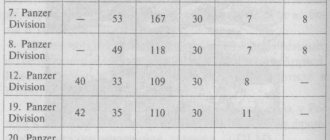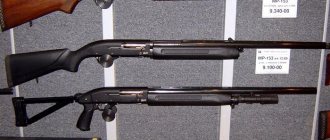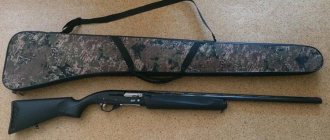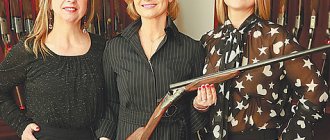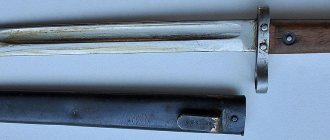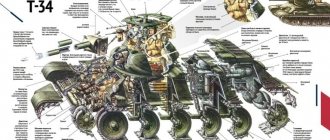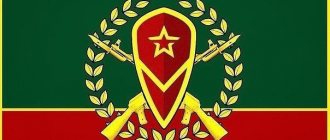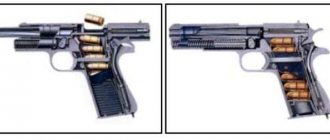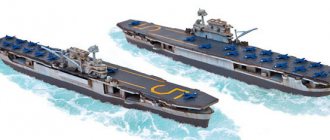On this day, June 10, 1807, construction of the famous Izhevsk arms factory began. For more than two centuries, the company has changed its name more than once, but one thing has remained constant - Izhevsk has always remained one of the main weapons forges in the country.
Today the company is called the Group and is the flagship of the domestic shooting industry. About the history of the legendary Izhevsk weapons: from “kremnevok” to the world famous “Kalashnikov” - in our material.
The beginning of a legend
At the beginning of the 19th century, a rather difficult foreign policy situation developed in Europe. In particular, growing tensions with Napoleonic France forced Russia to think about reforms in the arms industry and strengthening its defense capabilities.
It was decided to build a new powerful weapons factory, which will be capable of producing up to one hundred thousand units of bladed weapons and firearms per year, in the Urals. In total, during the period from 1800 to 1807, several projects and proposals for the construction of a new enterprise were drawn up. The author of one of them was Andrei Deryabin, Oberberghauptman (chief mining commander) of the Goroblagodat, Perm, Kama and Bogoslovsky factories. He studied in detail a number of places in the Perm and Vyatka provinces and came to the conclusion that the most suitable place for an arms center was the Izh River, where at that time there was already an ironworks.
The government of Alexander I approved the project, and on June 10, 1807, under the leadership of Andrei Deryabin, construction of the Izhevsk arms factory began. This day, when the official opening of the Izhevsk arms office took place, is considered to be the birthday of the plant.
Construction proceeded at an impressive pace for that time: by 1816 there were already 10 stone factories, several wooden buildings, and the main building with a factory tower was laid.
By the way, Emperor Alexander I, by whose order the enterprise was founded, was considered the patron of the Izhevsk arms factory and paid great attention to it. Sometimes in official documents the plant was even called the Kama-Izhevsk Alexandrovsky plant. In October 1825, Alexander I personally visited the enterprise. In subsequent years, one of the country's main arms forges was visited by many distinguished guests, including Leonid Brezhnev, Boris Yeltsin, Venezuelan President Hugo Chavez, Dmitry Medvedev, Vladimir Putin, as well as many other politicians and foreign delegations.
Model overview
We will look at the main modifications of guns manufactured at the Izhevsk Mechanical Plant.
IZH-59 / MP-59
The IZH-59 Sputnik hunting rifle was produced before the sixty-fourth year. This is a gun with two drums, vertically coupled. As noted earlier, the trigger was located separately in the receiver, and not together. This feature allows you to quickly remove cleaning or fastening mechanisms. The bush was closed in a whisper and was not automatic.
This weapon could fire up to thirty thousand rounds, it was quite durable. The gun is designed for both hunting and other activities.
IZH-12
The gun is an improved version of the IZH-59, providing improved stability thanks to attached vertically mounted muzzles. The barrel length is also reduced to 695 millimeters. Increased safety thanks to the installation of an automatic fuse.
From “Kremnevka” to “Kalashnikov”
The first product of the new plant in Izhevsk was the “kremnevka” - a soldier’s smooth-bore seven-line gun of the 1808 model. Its production was considered one of the most massive at that time: more than six thousand of these guns were created for Kutuzov’s army alone during the war.
In Izhevsk, in addition to flintlocks, pistols, Jaeger, Lancer and Horse Guards rifles, cuirassier and hussar carbines, and dragoon muskets were produced. The plant also melted down captured and obsolete guns, from which parts for new ones were made here.
During the Crimean War of 1853-1856, the Izhevsk plant produced more than 130 thousand guns. The subsequent Russo-Turkish War of 1877-1878 accelerated the pace of production. Moreover, work was also carried out on the development of new models. In those years, one of the most popular products of the Izhevsk Arms Plant was a small-caliber four-line rifle of the Berdan system.
The next weapon that brought the Izhevsk plant many years of fame is the Mosin repeating rifle. It was mass-produced at the enterprise for about half a century, since 1891. Moreover, all varieties of Mosin’s “three-line” were produced only in Izhevsk. In total, during the period from 1891 to 1945, about 57 million weapons designed by Mosin were produced here.
Thus, the “mosinka” managed to fight on the fields of the Great Patriotic War. In 1941, Izhevsk gunsmiths issued 12 thousand “three-line guns” per day. In total, during the war years, 20 types of military equipment were produced in Izhevsk, and on a huge scale, like no other defense enterprise in the world.
The Izhevsk Machine-Building Plant, into which the Izhevsk Arms and Steelworks were renamed in 1937, produced for the front SVT, TT, Nagan revolvers, Degtyarev and Simonov anti-tank rifles, UB-12.7 aircraft machine guns, ShVAK and NS-37 aircraft guns and many other samples. In total, 11.3 million rifles and carbines were produced in Izhevsk during the war years. For comparison: during the same time, all German factories together produced about 10 million barrels.
This colossal experience became the basis for the development and production of perhaps the most legendary weapon of the last century - the Kalashnikov assault rifle. Development of the assault rifle began in 1947, and for many years the AK became the hallmark of the plant. Its creator, Mikhail Timofeevich Kalashnikov, began working at the plant in 1948 and worked here until the end of his life. It is no coincidence that the Kalashnikov brand eventually became the name of the entire arms concern, organized in 2013 on the basis of Izhmash.
Mikhail Timofeevich often recalled his work at.
At the Izhevsk Machine-Building Plant, under the personal leadership of Kalashnikov, dozens of prototypes of automatic small arms were developed on the AK basis. The Kalashnikov assault rifle continues to improve today.
One of the new products was the recently adopted AK-12 assault rifle, designed to replace the AK-74, which has been used in the army for more than 40 years. The first batch of AK-12s entered the Russian Armed Forces at the end of 2022; in just one year, four thousand units were delivered. Foreign partners are already showing interest in the new assault rifle: the first export contract for the supply of AK-12 has been signed with Armenia.
Kalashnikov plans to release a whole series of products based on the AK-12. On its basis, the RPK-16 light machine gun has already been created with two types of barrels, which can also be used as an assault rifle. The plans include the release of a civilian version of self-loading carbines and the production of AK-12 variants for international cartridge calibers.
Vertical option
IZH-59 is the best model with a vertical version, designed in the Izhevsk factory. Their trunks were not yet welded and their connections were tied to their connection. The trigger mechanism is fixed on a separate base. The safety is not automatic, but there is a possibility for a smooth release.
The next stage of the rifle was the modernized model IZH-12, in which the barrels were welded to each other to correct the main drawback of the predecessor, associated with the fact that the centers of the charge axes were mixed. Today, one of the most recognizable vertical trunks is the IZH-27 based on the IZH-12.
Concern "Kalashnikov": weapons, drones and more
Today the Group includes three weapons brands: Kalashnikov - military and civilian weapons, Baikal - hunting and civilian weapons, Izhmash - sporting weapons.
Hunting carbines based on Kalashnikov assault rifles “Saiga” have long been popular among hunters, like other families of hunting weapons: “Sable”, “Tiger”, “Elk”.
Also, for many years, the Izhevsk plant has been the leading domestic manufacturer of sports weapons and the only enterprise in our country that produces rifles for biathletes. The famous designer Evgeny Fedorovich Dragunov was at the origins of the creation of weapons for sports. The first sporting rifle under his leadership was manufactured in 1949. With an Izhevsk rifle in their hands, more than one generation of athletes from many countries has achieved records and Olympic awards.
Since 2015, Kalashnikov has been developing new areas of activity - remotely controlled combat modules, unmanned aerial vehicles and multifunctional special-purpose boats.
Kalashnikov continues the traditions of the legendary enterprise, which has been one of the main forges in the country for two centuries. Today anyone can get acquainted with the amazing history of the Izhevsk plant: in the very center of Izhevsk, in honor of the 210th anniversary of the founding of the enterprise, the Izhmash Museum has been opened. A unique collection of exhibits demonstrates to visitors the two-century history of the development of weapons in Russia.
Horizontal option
The first horizontal shotgun rifle was the IZH-41. The original design provides a unique trigger mechanism: two hooks, each of which operates on its own reel. This mechanism can be easily removed by pressing the lock button. The carriages were installed separately, and there was a double locking mechanism for the suitcases and automatic fuse.
Then a number of hunting rifles IZH-54, 52, 43 and 58 were produced. Finally, they improved the trigger, increased reliability and safety.
Izhevsk is the arms capital of Russia
Batalova L.V., Okonnikova T.I.
In modern conditions, the formation of a tourist brand is one of the fundamental tasks for most Russian territories seeking to develop domestic and inbound tourism. These include Udmurtia, a region that for a long time was considered closed due to the defense specialization of most enterprises concentrated both in the capital of the republic - Izhevsk, and in other cities and towns. Undoubtedly, this fact played a decisive role in the situation where the Udmurt Republic has an established image of a “non-tourist” territory.
Currently, within the framework of the implementation of the republican target program “Development of domestic and inbound tourism in the Udmurt Republic for 2012-2018”, approved by the Decree of the Government of the Udmurt Republic dated June 4, 2012. No. 237 [21], targeted efforts are being made to form and promote a positive tourist image of the territory, using the resources of the media, the Internet, Russian and international exhibitions [14].
Most often, the names of outstanding personalities are used as symbols creating a recognizable image of Udmurtia: weapons designer M.T. Kalashnikov, composer P.I. Tchaikovsky, skier, 4-time Olympic champion, 9-time world champion, World Cup winner G.A. Kulakova, hero of the Patriotic War of 1812, writer N.A. Durova. The second hypostasis, which serves as the basis for the formation of an attractive image, is the ethnocultural component, based on the well-preserved traditional culture of the indigenous people - the Udmurts, who belong to the Finno-Ugric language group. The republic regularly hosts mass events of ethnocultural orientation (folk holidays “Gerber”, “Semyk”, regional folklore festival of the Finno-Ugric peoples of the Volga region and the Urals “Vorshud”, International Finno-Ugric festival of youth ethnoculture “Palesyan”, held in 2013 International Buranovsky Festival of Folk Culture, etc.). Large archaeological monuments in the region have been well studied (for example, the medieval settlement of Idnakar), on the basis of which it is possible to create tourist complexes on ethnocultural themes [2]. The second aspect goes well with the ecological component of the republic’s tourism and recreational potential – the source of the river. Kamas in the outback of Udmurtia, nature reserves, hunting grounds, etc.
Thus, under certain conditions, the recognition of Udmurtia outside its borders and the attractiveness of the republic for tourists can be based on different grounds or a combination of them. In this regard, to create an attractive image of the region, special attention should be paid to its cultural and historical component, which covers the sum of ideas about the region associated with the totality of material and spiritual values created by man within the region. [5, p. 132]
But for the capital of the republic - the city of Izhevsk - the name of designer M.T. has the highest chance of becoming a brand-forming symbol. Kalashnikov and the image of Izhevsk as a weapons capital that developed over two centuries. Thus, ironically, it is precisely those factors that have long delayed the development of tourism in the region that, in our opinion, are called upon to play a leading role in overcoming both the city of Izhevsk and the Udmurt Republic as a whole the image of a “non-tourist” territory.
The purpose of this article is to analyze the historical and cultural foundations of the formation of the tourist brand “Izhevsk - the arms capital of Russia”. Setting the goal led to the need to solve the following tasks:
- Analysis of the formation and development of weapons production in Izhevsk and the formation of the image “Izhevsk is a city of gunsmiths”;
- Exploring the role of M.T. Kalashnikov in the development of the image of Izhevsk as the weapons capital of Russia;
- Unlocking the potential of historical and cultural heritage sites and museums of Izhevsk in the formation of the tourist brand “Izhevsk - the arms capital of Russia.”
There are currently no special scientific studies on the formation of a tourist brand in Izhevsk, although discussions on this topic, initiated by the city authorities, are periodically conducted. The history of Izhevsk as a factory city, a city of gunsmiths, is well covered in scientific and popular science literature. As a rule, they are based on the works of Doctor of Historical Sciences, Professor of Udmurt State University E.F. Shumilov [24,25,26,27]. Description of the life and work of M.T. A large number of sources in the autobiographical and memoir genres [9, 10, 11], as well as publications by various authors [7, 12, 19, 23, etc.], are devoted to Kalashnikov.
The formation and development of weapons production at the Izhevsk plant and the formation of the image “Izhevsk is a city of gunsmiths”
The formation of the image of Izhevsk as a city of gunsmiths is associated with the organization of arms production on the territory of modern Udmurtia at the beginning of the 19th century. The question of opening an arms factory in the Urals (by that time there were ones in Tula and Sestroretsk) was raised in connection with the impending war with Napoleon. It was decided to start weapons production on the basis of the Izhevsk ironworks, created in 1760 on the initiative of Count P.I. Shuvalova. The opening of the plant was entrusted to the mining engineer of the early 19th century, Oberberghauptmann IV class, commander of the Ural Goroblagodatsky, Perm, Kama and Bogoslovsky factories and manager of the Dedyukhinsky salt mines Andrei Fedorovich Deryabin (1770-1820), who determined the location of the Izhevsk ironworks [6] On June 10, 1807, the plant was founded with the grand opening of the Armory Office. The plant was built as the most modern enterprise in a technical and technological sense; foreign specialists were invited to organize production and train local craftsmen. And already during the Patriotic War of 1812, the plant supplied more than 6 thousand guns to the Russian army, increasing production by 1814. up to 20 thousand units, and by the mid-1870s. – up to 70 thousand units[16]
Until 1844, the plant produced flintlock guns, from 1844 to 1856 - smoothbore percussion-capsule guns, after the Crimean War (1853 - 1856), the transition to rifled weapons began. From 1867 to 1874, the Izhevsk Arms Plant was engaged in the manufacture of rifled, 6-line, conversion rifles of various systems. In 1874, the plant switched to the production of 4-line rifles of the Berdan system, and in 1891 the production of 3-line rifles of the 1891 model began. Izhevsk weapons were one of the highest quality and received well-deserved recognition: at the Siberian-Ural Exhibition In 1887, for success in the manufacture of domestic weapons, the Izhevsk plant was awarded a large gold medal; in 1900, at the World Exhibition in Paris, Izhevsk-made barrels won another gold medal [16]. In the second half of the 19th century. The Izhevsk plant was leased several times to different owners due to the need for serious investments in the reorganization of production (in particular, from 1771 to 1879, the co-tenant of the enterprise was L.E. Nobel, the brother of the inventor of dynamite A. Nobel)[6], but then it was again transferred to the treasury. Since 1872, the plant began to be called the Izhevsk Arms and Steel Plant”[16].
In general, during the first 100 years of its existence (1807-1808), Izhevsk gunsmiths produced more than 4 million units. various weapons [16], and the Izhevsk plant received recognition as a world-class weapons center. During the years of the October Revolution and the Civil War, difficult events took place in Izhevsk, which created a certain threat of a break in the traditions of arms making. In 1918, the Izhevsk plant became the center of major military-political upheavals, interpreted as the Izhevsk-Votkinsk anti-Bolshevik uprising. The workers of the plant formed the People's Army, known as the Izhevsk Division. From August 8, 1918 to June 8, 1919, the plant was captured either by the Red Army or by White Guard units. Before the final assault by the Red Army, some of the workers and employees of the plant left with the Kolchak army, and the main equipment was also removed [6].
However, in subsequent years, military production in Izhevsk was resumed and began to strengthen. In the 1930s steel and weapons production were separated - separate ones and Izhmash appeared, a large-scale reconstruction of production was carried out, which resulted in the development of a number of new types of weapons. Among them is 7.62 mm. rifle model 1891/30, Simonov automatic rifle (AVS), Tokarev self-loading rifle (SVT), etc. [16].
During the Great Patriotic War, after the evacuation of several defense enterprises from the west of the USSR to Izhevsk, the Izhevsk Machine-Building Plant literally turned into the weapons capital of our country. The plant managed to increase the production of the Mosin three-line rifle to 12 thousand units and thereby armed the rifle division every day. In total, during the Great Patriotic War, 11 million 145 thousand rifles and carbines, more than 15 thousand aircraft guns, and almost 132 thousand anti-tank guns were produced in Izhevsk[16].
In the post-war period, Izhevsk became the center of the formation of a high-tech military-industrial complex. The high concentration of defense enterprises of various profiles (the largest of them: Izhevsk Machine-Building Plant) - a direct “descendant” of the Izhevsk Arms Plant, Izhevsk Mechanical Plant, Izhevsk Electromechanical Plant) led to an influx of highly qualified personnel into military production. Izhevsk became not just a center of weapons production, but also an intellectual leader in the field of engineering design, whose world-famous representative was M.T. Kalashnikov is the creator of the most common small arms in the world, which has a reputation as the most reliable and easy to use.
Thus, Izhevsk is a unique city, the history of which is connected primarily with weapons production. The image of Izhevsk as a city of gunsmiths was formed in the pre-Soviet period, and in subsequent times, with the expansion of defense production in the city, this image became even stronger and was supplemented by new symbols, the most striking of which was the name of M.T. Kalashnikov.
The role of M.T. Kalashnikov in the development of the image of Izhevsk as the weapons capital of Russia
Mikhail Timofeevich Kalashnikov (1919-2013) - gunsmith designer who brought world fame to Izhevsk weapons
Mikhail Timofeevich Kalashnikov (1919-2013) [15]
In Izhevsk M.T. Kalashnikov ended up in 1948, where he was sent to master the model and manufacture a military batch of the AK-47. By that time he already had a war behind him, where he was seriously wounded in the battles near Bryansk in October 1941.
Design talents M.T. Kalashnikov appeared even before the war - while still serving in the army at the end of the 1930s. he developed an inertial counter to record the actual number of shots fired from a tank gun, made a special device for the TT pistol to increase the efficiency of firing through slits in the tank turret, and created a device for measuring the service life of a tank engine. After being wounded, while on six-month leave for health reasons, M.T. Kalashnikov developed his first model of a submachine gun. In addition, until 1944 M.T. Kalashnikov developed a light machine gun and a self-loading carbine. In 1945, he took part in a competition to develop an assault rifle chambered for the 1943 model. Based on the results of competitive tests in 1947, the AK-47 assault rifle was recommended for adoption by the Soviet Army [13]. Its mass production began at the Izhevsk Machine-Building Plant. The assault rifle received the official name - “7.62 mm Kalashnikov assault rifle model 1947 (AK).” For this development M.T. Kalashnikov received the Order of the Red Star and the Stalin Prize of the first degree.
From that time on, the fate of M.T. Kalashnikova was forever associated with Izhevsk. Since 1949, Mikhail Timofeevich began working in the department of the chief designer of the Izhevsk Machine-Building Plant, where more than a hundred samples of military weapons were created. In 1971, based on the totality of research and development work and inventions of M.T. Kalashnikov was awarded the academic degree of Doctor of Technical Sciences. Lieutenant General Mikhail Kalashnikov is twice Hero of Socialist Labor, laureate of the Stalin and Lenin Prizes, Hero of Russia[13].
In February 2012, during the reorganization of the enterprise M.T. Kalashnikov was transferred to the staff of the Izhmash Research and Production Association (NPO Izhmash) to the position of chief designer and head of the small arms design bureau of the Design and Technology Center of the enterprise [13]. In this position M.T. Kalashnikov worked until the end of his life; he died on December 23, 2013. Today the plant where Mikhail Timofeevich Kalashnikov worked for 65 years bears his name. On August 12, 2013, NPO Izhmash was renamed OJSC Concern Kalashnikov. Currently, the company produces the fourth generation of Kalashnikov assault rifles - AK “hundredth” series: AK-101, AK-102, AK-103, AK-104 , AK-105. For special forces and law enforcement forces of the country, sniper rifles SVD, SVDS, SV-98, SV-99, SV-338 are produced, as well as the Vityaz submachine gun, the 18.5 KS-K carbine and a number of other models. The production of civilian weapons is constantly growing. Hunting rifles “Saiga”, created on the basis of the Kalashnikov system, carbines “Tiger”, “Sable”, “Elk”, “Bear”, “Bars” and others are deservedly popular. In 2012, the company offered hunters new modifications of hunting rifles - “Los-10” and “Los-11”. For many years, the plant has been the leading Russian manufacturer of sports weapons and the only enterprise producing rifles for biathlon [17].
Currently the name M.T. Kalashnikov is an almost ideal brand-building symbol, since the atmosphere of secrecy that was maintained around defense production in Soviet times extended to the identity of the AK-47 designer. Accordingly, Kalashnikov was perceived not so much as a real figure, but rather as a legendary image. Few of the “uninitiated” knew then that Mikhail Timofeevich was a man who lived in Izhevsk and worked at the Izhmash design bureau. In today's conditions, the name M.T. Kalashnikov, the association with the plant where the AK-47 is produced is what ensures the recognition of Izhevsk on a global scale. Thus, the legendary aura that remains around the name of Kalashnikov creates favorable conditions for increasing interest in Izhevsk as a tourist destination.
Moreover, the Kalashnikov weapons brand is not so much a regional brand, but a national-level brand, since in the world “Kalashnikov” and “Russia” are an even more stable association than the association “Kalashnikov” and “Izhevsk”. At the same time, Izhevsk, where the current Kalashnikov concern, which was recently transformed into a concern, and the unique museum collections of weapons produced at this enterprise are located are the material embodiment of the Kalashnikov image, and this determines significant opportunities for the development of Izhevsk as a tourist center of Russian and world scale.
The potential of the historical and cultural heritage and museums of Izhevsk in the development of the brand “Izhevsk - the arms capital of Russia”
In Izhevsk, a number of objects associated with the beginning of weapons production have been preserved to this day. All of them have the status of cultural heritage sites and are characterized by high tourism potential, since they largely reflect the history of the development of the arms industry and the city of Izhevsk as a whole. The main building of the Izhevsk Arms Factory is a unique work of industrial architecture in Russia at the beginning of the 19th century, playing a leading urban planning role in Izhevsk.
Main building of the Izhevsk Arms Plant [4]
Construction of the main building of the plant began in 1811 on behalf of A.F. Deryabina. The author of the project was a graduate of the Academy of Arts S.E. Dudin (1779-1825). The building is made in the style of high classicism. S.E. Dudin, for the first time in Russia, combined the technical idea of organizing a production cycle with an architectural solution in the form of a four-story industrial building made in the style of high classicism. In March 1834, the Main Building of the Izhevsk Arms Factory was almost destroyed due to a major fire. Restoration work was carried out from 1836 to 1838, then the plant building was completed and rebuilt according to new drawings approved by Nicholas I. The final year of completion of the construction of the Izhevsk arms factory is considered to be 1844. Today, the main building of the plant and its multi-tiered round 50-meter tower with chimes, crowning the building, is a symbol of the city of Izhevsk [4].
Opposite the central tower of the Main Building of the Izhevsk Arms Plant in 1907 there is a bust of its founder Andrei Fedorovich Deryabin. The author of the monument is I.N. Sitnikov.
Monument to the founder of the Izhevsk arms factory A.F. Deryabin[3]
A.F. Deryabin is presented in a uniform from Alexander's times with the Order of Anna and a ribbon over his shoulder. The bust of the founder of the plant was placed on the dam of the Izhevsky pond opposite the Main building, along the same axis with its central tower. On the bronze plaque placed on the back side of the pedestal, it is indicated that the monument “was built in memory of the centenary of the Izhevsk arms factory, June 10, 1807 - June 10, 1907.” Now the embankment area near the monument to A.F. Deryabin is one of the most famous places in the city of Izhevsk. In a certain sense, it is precisely this that is associated with the beginning of the city of Izhevsk, the place of its birth [3].
The Izhevsky Pond and its dam played an important role in weapons production. The history of the creation of the Izhevsky Pond goes back to the mid-18th century, when an ironworks was established here. Construction of a dam on the river. Izh began on April 10, 1760 and ended in June 1763. The establishment of weapons production at the plant in 1807 necessitated a radical modernization of the dam, which was carried out in 1816-1824. according to the project and under the guidance of S.E. Dudina. This made it possible to meet the needs of the growing weapons production for energy resources. During Soviet times, the pond gradually lost its industrial significance. Water wheels and even turbines disappeared already during the NEP, they were replaced by electric motors. In 1983-1984, the body of the dam was expanded twice, the embankment was improved [8]. Currently, its reconstruction is underway, as a result of which the embankment has been transformed in terms of aesthetic appeal and comfort for vacationing citizens and guests of Izhevsk.
Another historical object associated with the emergence of weapons production at the Izhevsk plant is the Alexander Nevsky Cathedral.
Alexander Nevsky Cathedral in Izhevsk [22]
The construction of the cathedral was caused by the fire of 1810, which destroyed a significant part of Izhevsk with the main temple - the Church of St. Elijah the Prophet. The project of St. Andrew's Cathedral in Kronstadt was approved as a model for a new temple. The project drawings were corrected by S.E. Dudin, taking into account the conditions for its implementation in the new location. Construction of the temple took place from 1816 to 1823. financed by the Artillery Department. Alexander Nevsky Cathedral became the main parish church of Izhevsk. Currently, after the ups and downs of the Soviet era, when the cathedral was closed and converted into a club, and then a cinema, it is the Orthodox cathedral of the Udmurt diocese[22].
Another architectural treasure of Izhevsk is the building of the Arsenal of the Izhevsk Arms Factory.
Arsenal. Izhevsk Kremlin [1]
Like the previous objects, it is also the creation of the architect S.E. Dudina. Construction of the Arsenal began in 1823 and was completed in 1827. Emperor Alexander I, who came to the Izhevsk plant in 1824 and visited the Arsenal, awarded S.E. Dudin for this creation was awarded the Order of Vladimir, 4th degree. The three facades of the building were designed by the architect in the style of Russian classicism and are compositionally built in the same way: in the center there are solemn six-column porticoes with triangular pediments, on the sides there are slightly protruding wings-risalits. The building is U-shaped, its open part faces south and all rooms of the building receive maximum natural light during the day. In the center of the courtyard there is a building for assembling and cleaning weapons; it also housed a factory school, where from an early age they taught the secrets of the profession of weapon assemblers and masters of their acceptance. The total area of the Arsenal was 3,000 sq.m. During the First World War, a 2-story building was built on the south side of the Arsenal building, which was due to the expansion of production. The building housed a stock workshop. Today the residence of the Head of the Udmurt Republic is located there. In 1970, exhibitions of the Udmurt Republican Museum of Local Lore (since 1995 – the National Museum of the Udmurt Republic) opened in the eastern wing of the Arsenal. In 1987-1994 reconstruction was carried out, after which the entire Arsenal building was transferred to the museum [1].
The pearl of modern Izhevsk, the embodiment of the city as an arms capital, is the museum, which is located in the building of the former Money Pantry (built in 1804 - the oldest building in Izhevsk) (architect A. Kokovikhin), rebuilt in 1852 into the Guardhouse. It houses a unique collection of samples of firearms and bladed weapons produced by the Izhevsk plant during its more than two-century history [16,17]. Currently, the museum exhibits more than 350 samples of firearms and bladed weapons. The collection of the Izhmash Museum was published in the form of a catalog, published in a revised and expanded version for the 200th anniversary of the plant [20].
Of the modern objects, the Museum and Exhibition Complex of Small Arms named after M.T. has the greatest tourist potential. Kalashnikov. Opened in 2004, it immediately became a landmark of Izhevsk. If the museum’s exhibitions are presented to visitors in a classic version - the very appearance of the small historical museum building and its interiors are conducive to this, then the Museum and Exhibition Complex of Small Arms named after M.T. Kalashnikov Museum is a modern museum that uses innovative technologies for museum and exhibition activities. The central place in the introductory part of the exhibition is occupied by a video installation, which is built on the basis of a non-militaristic interpretation of weapons. The history of the development of weapons manufacturing is presented as part of world technical thought. The permanent exhibition, “The Fate of Man,” illuminates the life path of M.T. Kalashnikov and his design achievements. The exhibition presents unique material: documents from the family archive, personal belongings, awards and inventions. The museum has created installation complexes “Peasant Hut”, “Hospital in Yelets”, “Test Range”, “Design Bureau”, “Experimental Workshop”, recreating the spirit of the time and the places of the events being experienced. From the plasma screens, M. T. Kalashnikov shares his memories of key life events, he talks about the time and himself. The museum complex has also created a demonstration hall, including a modern firearms shooting range, where you can see examples of historical and modern weapons, as well as a pneumatic and crossbow shooting range, equipped with multimedia programs [18].
Historical sites and museums of the city are actively involved in tourism activities. Residents and guests of the capital of Udmurtia are offered excursions “Izhevsk - the city of gunsmiths”, “Izhevsk - the arms capital of Russia”, visits to objects related to the history of weapons - a mandatory component of a sightseeing tour of the city, excursion “Historical Izhevsk”. Tourists enjoy exploring the exhibitions of the museum and the museum and exhibition complex named after. M.T. Kalashnikov. But it must be admitted that today Izhevsk is not perceived as a tourist center. The internal tourist flow is provided mainly by schoolchildren and students. The external tourist flow consists of a few guests of the capital of Udmurtia, usually business travelers who came for business purposes. Therefore, clear positioning of Izhevsk as a tourist center and its active promotion is the most important task of today.
Thus, an analysis of the historical and cultural foundations for the formation of the image “Izhevsk - the arms capital of Russia” proves its viability as a viable and attractive tourist brand. As has been shown, Izhevsk is in an advantageous position in terms of branding - most Russian territories often have to literally come up with brand-building symbols and legends (not always successful), spend money on their “promotion”. Izhevsk has a direct connection with the worldwide arms brand “Kalashnikov”, and efforts should be aimed at strengthening the association “Kalashnikov” - “Izhevsk - the arms capital of Russia”, as well as creating and promoting a high-quality tourism product based on these images. Moreover, the brand “ Kalashnikov is a national brand, and a very “strong” brand at that. The fame of the name M.T. Kalashnikov and the Kalashnikov weapons brand are so large-scale and so associated with the image of our country that their significance is great for promoting the tourist attractiveness of Russia as a whole.
Literature
- Arsenal. Izhevsk Kremlin. https://www.izh.ru/i/info/16539.html (access date: 05/20/2014).
- Batalova L.V., Okonnikova T.I. Museum-reserve “Idnakar” as the basis for creating a tourist cultural, historical and natural complex // Modern problems of service and tourism. - 2012. - No. 1. - P. 25-31.
- Bust of A.F. Deryabin, founder of the Izhevsk arms factory. https://www.izh.ru/i/info/16538.html (access date: 05/20/2014).
- The main building of the Izhevsk arms factory. https://www.izh.ru/i/info/16540.html (access date: 05/20/2014).
- Dzhandzhugazova E.A. Marketing of tourist territories. –M., “Teis”, 2004.
- Dobreitsina L.E., Sannikova T.O. Historical cities of the Urals. Part 3. Historical cities of the Urals: the Republic of Udmurtia and the Perm Territory. - Ekaterinburg: Ural Publishing House. Univ., 2012. - 132 p.
- Zhukov V.N. Second birth. (documentary story about M.T. Kalashnikov). - M., 1977. - 111 p.
- Izhevsky pond. https://www.izh.ru/i/info/14685.html (access date: 05/20/2014).
- Kalashnikov M.T. Kalashnikov: trajectory of fate. - M.: Publishing house. House “All Russia”, 2004. - 639 p.
- Kalashnikov M. T. From someone else’s threshold to the Spassky Gate. - M.: Military Parade, 1997. - 496 p.
- Kalashnikov M. T. I walked the same road with you. - M.: Publishing house. House “All Russia”, 1999.- 239 p.
- Koryakovtsev L. G. Unknown Kalashnikov. - St. Petersburg, 2004. – 268 p.
- M.T. Kalashnikov. Biography. https://museum-mtk.ru/armourers/kalashnikov/biography/ (access date: 05/20/2014).
- Materials of the final meeting of the board of the Ministry of Physical Culture, Sports and Tourism of the Udmurt Republic. Izhevsk, 2013. https://sportturizm.udmurt.ru/lines/Kollegiya_02_2013.doc (date accessed 03/20/2014).
- Mikhail Timofeevich Kalashnikov photo: MAXIM MARMUR/AFP.https://rus.postimees.ee/186038/mihail-kalashnikov-otmechaet-90-letie
- Museum "Izhmash". Booklet / Compiled by: A.A. Azovsky, S.D. Gorbunov, G.A. Kovalyukh, N.G. Shibanova. Izhevsk, 2007. 8 p.
- Izhmash Museum // https://www.kalashnikovconcern.com/about/museum/ (access date: 05.20.2014).
- Museum and exhibition complex of small arms named after M. T. Kalashnikov. https://museum-mtk.ru (access date: 05/20/2014).
- Kalashnikov weapons / Comp. A. Nedelin. - M.: Military Parade, 1997. - 241 p.
- Weapon. Collection of the Izhmash Museum. Catalog 2007. Second edition, corrected and expanded / Compiled by: Kovalyukh G.A., Gorbunov S.D., Portnov M.E.; Rep. editor - Kovalyukh G.A. - Izhevsk, 2007. - 192 p.
- Republican target program “Development of domestic and inbound tourism in the Udmurt Republic for 2012-2018.” Decree of the Government of the Udmurt Republic dated 06/04/2012 No. 237.
- Alexander Nevsky Cathedral.https://izhistory.ru/sobor-aleksandra-nevskogo/sobor-aleksandra-nevskogo.html
- Sokolov V.V. Kalashnikov: my friend, as I know him. - Izhevsk: Accent, 2001. - 189 p.
- Shumilov E.F. Architecture of Izhevsk. History of development and prospects of architecture, urban planning and monumental art. Izhevsk: Udmurtia, 1978. 116 p.
- Shumilov E.F. City on Izha, 1760 – 2000. – Izhevsk: Svitok, 1998. – 399 p.
- Shumilov E.F. Two centuries of “Izhmash” (Volume one). 1807-1917. City of gunsmiths. - Izhevsk: JSC "Izhmashprint", 2007. - 507 p.
- Shumilov E.F. Two centuries of “Izhmash” (Volume two). Plant of factories. 1917-2007. - Izhevsk: JSC "Izhmashprint", 2007. - 707 p.

